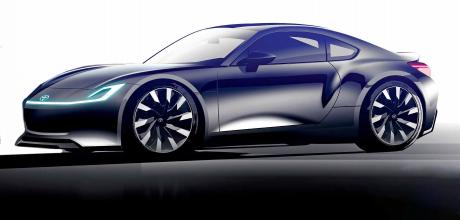Toyota GR86 successor Hybrid sports car mooted
Toyota plots hybrid GR86 heir. Firm’s tech chief stands by hybrids but says slimline batteries are key to EVs’ future.
Toyota may be planning to replace its time-limited GR86 sports car as early as 2025 with a redesigned hybrid version that sits on a new platform and uses the turbocharged three-cylinder engine that already powers the much-admired GR Yaris. Reports from Japan suggest that the current version of Toyota’s two-door sports coupé, launched early in 2021, will need to be removed from sale within two years because it will no longer comply with forthcoming Japanese fuel consumption and emissions standards. Another factor is that its windscreen dimensions may no longer suit the advanced European safety systems – believed to be traffic light recognition cameras – that will be required in new cars from next year.
Speaking exclusively to DrivesToday during the Goodwood Festival of Speed, Toyota chief technology officer Hiroki Nakajima declined to confirm the plan for an all-new GR86 hybrid but agreed that such a car was “a good idea”.
“Hybrid systems are always a good solution for environmental cars,” he said, “not just for passenger cars but for sporty cars as well. We can build them at a lower price than battery-electric models, and we know how to make them fun to drive.”
Nakajima added that there are still nearly 12 years to go before the sale of hybrid cars partly powered by internal combustion engines will be outlawed in the UK and Europe.
Toyota has long been outspoken on the virtues of hybrid technology, positing electrified combustion-engined cars as a more efficient and impactful use of currently limited battery resources. The firm has previously voiced plans to deploy its long-awaited solid-state batteries in hybrids before pure-EVs, but this is the first time it has hinted at the potential for a hybrid mass-market sports car.
Toyota’s Gazoo Racing performance division has form in the hybrid sphere, of course, having won the Le Mans 24 Hours five times on the bounce between 2018 and 2022 with its TS050 and GR010 electrified hypercars. Plans for a road-going ‘GR Super Sport’ variant of the latter were, however, shelved in 2021, and the firm’s sports car line-up remains entirely combustion-powered, at least for now.
On the subject of the much-talked-about electric Toyota GR car, Nakajima said reducing the height of traction batteries carried in the floorpan of BEV models will be “the breakthrough” needed to build lower, sleeker and more interesting electric cars.
He said a lower battery height was “the key to success” for the dynamic and desirable saloons and sports cars Toyota wants to build in the future, because it would promote aerodynamic shapes, reduce frontal area and allow ‘more emotional’ designs.
Better aerodynamics, working in tandem with Toyota’s recently announced solid-state battery technology, would make delivering a 1000km-plus battery touring range seem “not so special”.
Nakajima added: “If we also downsize major components like a car’s air-conditioning system, we can lower the cowl height and get a very good Cd value. We can realise a 1000km [620-mile] range, easily.”
Currently, Toyota and other BEV manufacturers work to a 150mm battery height, which suits the current BEV crossover and SUV models because there’s enough space to accommodate a bulky battery. However, Toyota is already changing to 120mm units and has a further reduction in its sights.
“Our target is 100mm,” said Nakajima, “so that in future we can build a battery Supra, for example.”
Toyota chairman Akio Toyoda recently revealed to DrivesToday that he had driven a prototype for an electric GR sports car, but he gave no details on its size, shape or positioning.
According to Nakajima, the challenge in building 100mm batteries for bigscale production is meeting current quality standards and delivering a fast-enough charging capability. The company is currently working on these problems through the 50/50 joint-venture company it owns with the electronics giant Panasonic.
Meanwhile, Toyota continues to make industry-leading progress at bringing its smaller, more energydense solid-state batteries to production. Insiders say the company is determined to bring a “true” solid-state battery to market, not one of the gel-based “semi-solid” versions that are under development elsewhere.
Current expectations are for the first Toyota-Panasonic solid-state application to be a relatively short-range mid-size van, due for launch at the end of 2026. A van is considered an ideal first application because a small battery can be carried in a well-protected space.
Solid-state units need ultra-rigid mounting because they could be prone to cracking if flexed.
Regulations are forcing the GR86 off sale, but a hybrid could follow New GR86 could use GR Yaris’s turbo three-pot.


